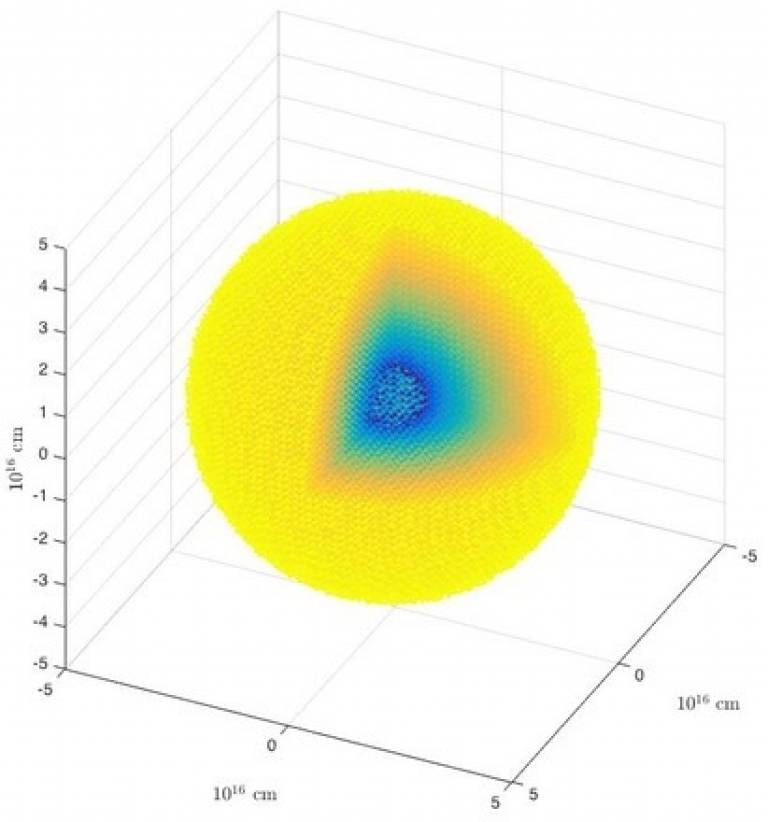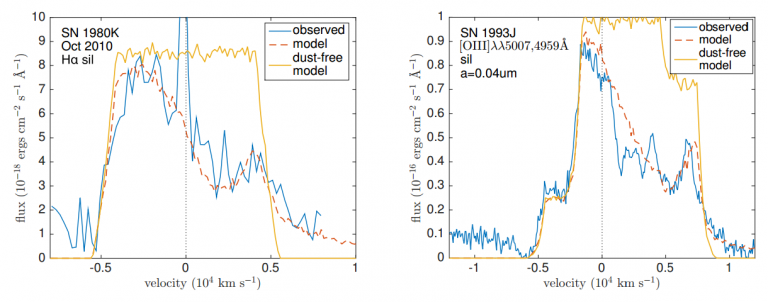The large quantities of dust observed in some high-redshift galaxies may have been produced by supernovae from massive stars, although a high dust formation efficiency of 0.1–1.0 solar masses per supernova appears to be required (Morgan & Edmunds 2003; Dwek, Galliano & Jones 2007). Quantitative determinations of the masses of dust formed in the ejecta of core-collapse supernovae have normally relied on modelling their thermal infrared dust emission spectra, (Dwek et al. 1983; Wooden et al. 1993; Sugerman et al. 2006; Gall, Hjorth & Andersen 2011; Gomez et al. 2012; Indebetouw et al. 2014; Matsuura et al. 2015, and other workers). However, even with the enhanced sensitivities of modern thermal IR instruments, it has been difficult to detect extragalactic SNe at wavelengths longwards of 8 μm more than 3 yr after outburst.

Figure 1. A smooth shell distribution of dust as generated by DAMOCLES
Blue-shifted line emission can be a common and long-lasting feature of the optical spectra of some core-collapse supernovae, with emission lines of oxygen and hydrogen often exhibiting red-blue asymmetries and significant substructure at both early times (e.g. SN 2006jc (Smith et al. 2008), SN 2005ip, SN 2006jd (Stritzinger et al. 2012) and SN 2010jl (Smith et al. 2012; Gall et al. 2014)) and at late times (e.g. Milisavljevic et al. 2012). If these lines can be modelled then it may be possible to determine the masses of dust in supernova ejecta and supernova remnants (SNRs). This is particularly useful at late-time epochs (~5 years) where core-collapse supernovae are not currently accessible at mid-infrared and longer wavelengths.

Figure 2. Modelled fits to the SN 1993J [OIII] λ5007,4959 Å doublet at 16 years and the SN 1980K Hα line at 30 years. The intrinsic dust-free modelled line profile is given in yellow, the dust-affected modelled line profile in red and the observed line profile in blue.
DAMOCLES (Dust Affected Models Of Characteristic Line Emission in Supernovae) is a 3D radiative transfer code designed to model single or doublet line profiles produced by a moving atmosphere in a dusty medium. It builds on the work of Lucy et al. (1989) who employed a similar approach to model the broad [O I] λλ6300,6363 Å doublet seen in SN 1987A at early epochs (up to ~day 775). Monochromatic energy packets are transported through an arbitrary distribution of dust such as a smooth or clumped shell or a bipolar distribution. A velocity field is specified and causes the initially monochromatic energy packets to be shifted in frequency as they are scattered by the dusty medium. Energy packets that are absorbed are removed from the simulation. Any number of dust species of arbitrary size distributions may be used and Mie theory is used to calculate the absorption and scattering efficiencies. The extinction due to dust is assumed to be temperature independent and it is therefore unnecessary to iteratively calculate the temperature of the ejecta as in a fully self-consistent calculation of the SED. Though clearly the total energy transferred through the medium is not conserved in the wavelength range of interest, the signature of the normalized line profile is preserved.
DAMOCLES has been used to model late-time optical line profiles from a number of core-collapse supernovae including SN 1980K, SN 1987A, SN 1993J and Cassiopeia A. Based on these models, we estimate dust masses at late times of 0.08-0.18 Msun for SN 1993J, 0.12-0.3 Msun for SN 1980K and ~1.1 Msun for Cas A. A series of models of the [OI] and Halpha line profiles for SN 1987A over a range of epochs was also produced. The derived dust masses as a function of epoch are consistent with continuous dust formation during the first few decades of ejecta evolution and final dust mass estimates of 0.4-0.7 Msun. These models indiciate that dust masses >~0.1Msun have formed in the ejecta of these objects supporting the case that CCSNe are the dominant sources of dust in the early Universe.
Relevant publications may be found at the following links:
Please contact antonia.bevan.12@ucl.ac.uk for further information.
 Close
Close

